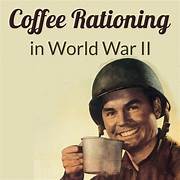On October 28, 1942, the United States implemented coffee rationing as part of its efforts to conserve resources during World War II. Coffee, a beloved beverage for many Americans, became a casualty of the war as supplies were redirected to support the troops and ensure the availability of essential goods. Coffee rationing had a significant impact on daily life and served as a reminder of the sacrifices made on the home front. During World War II, the United States faced numerous challenges in providing resources for its military personnel and supporting the war effort. Coffee, a popular and widely consumed beverage, was no exception. The government recognized that diverting coffee supplies to the military was necessary to ensure the troops' well-being and maintain morale. To manage the limited availability of coffee, the Office of Price Administration (OPA) implemented a rationing system. Under this system, individuals were issued ration books that contained coupons for various goods, including coffee. Each adult was initially allocated one pound of coffee every five weeks. This amount was later reduced to just one pound every six weeks. Coffee rationing had a profound impact on daily life during the war. Coffee had become an integral part of American culture and was often seen as a morning ritual or a social activity. With limited supplies, individuals had to adjust their routines and find alternatives to satisfy their caffeine cravings. To cope with the scarcity of coffee, people turned to substitutes such as chicory, roasted grains, or other ingredients that could mimic the taste and aroma of coffee. These substitutes, while not the same as real coffee, provided a semblance of the familiar beverage and helped alleviate some of the cravings. Despite the rationing, coffee remained a valuable and highly sought-after commodity. People would often trade or barter their coffee ration coupons for other goods or services. Coffeehouses and cafes that remained open during the war became popular gathering places, as they offered a chance to enjoy a cup of coffee and socialize. The rationing of coffee was not without controversy. Some individuals and organizations argued that coffee was not an essential commodity and should not be subject to rationing. Others believed that the rationing system unfairly favored certain groups or that the restrictions were unnecessary and infringed upon personal freedoms. Coffee rationing continued until the end of the war in 1945. As victory celebrations ensued, the restrictions on coffee were gradually lifted, and supplies began to flow more freely once again. The end of coffee rationing was met with relief and joy, as people could once again enjoy their favorite beverage without restrictions. The period of coffee rationing during World War II serves as a reminder of the sacrifices made by ordinary citizens on the home front. It highlights the collective effort to support the troops and conserve resources for the war effort. The rationing of coffee also demonstrates the resilience and adaptability of the American people, as they found ways to cope with limited supplies and make do with substitutes.
28 Oct, 1942 U.S.A. Coffee Rationing
